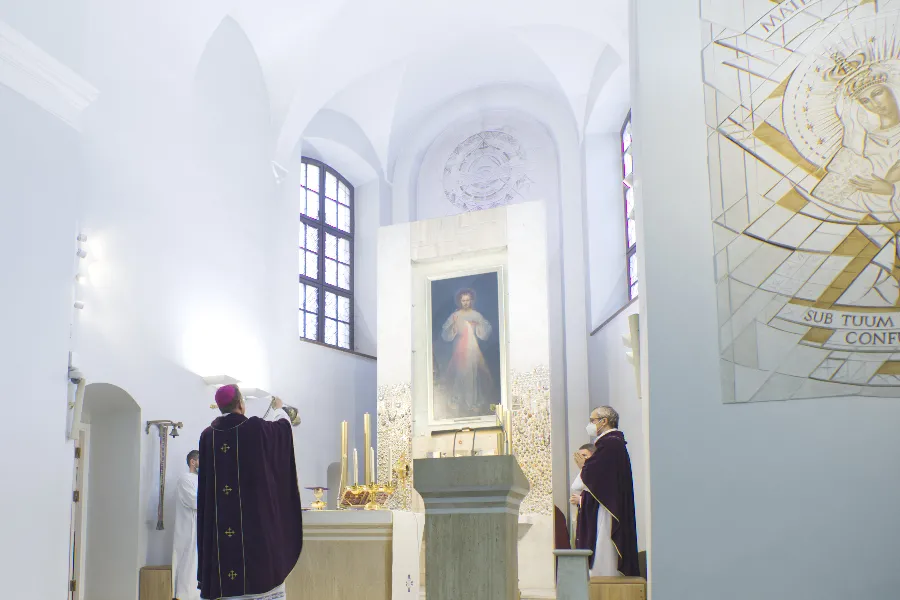
CNA Staff, Apr 7, 2021 / 07:00 am America/Denver (CNA).
Archbishop Gintaras Grušas believes that Lithuania has a “big message” for the world.
The archbishop of the country’s capital, Vilnius, points out that the city witnessed one of the most momentous events in 20th-century Catholic history.
It was there that the Polish nun St. Faustina Kowalska experienced many of the visions of Jesus that she recorded in her Diary.
The city contains the original Divine Mercy image, the only one that St. Faustina saw before her death in 1938 at the age of 33.
“We have the shrine to Divine Mercy, which is growing,” Grušas told CNA in an interview.
“The convent where St. Faustina lived and saw the revelations is still open. It’s a convent, but it’s also a pilgrimage site.”
He continued: “The four cities that are associated with St. Faustina — Warsaw, Kraków, Płock, and Vilnius — were given the mandate during her canonization by St. John Paul II to carry the banner of Divine Mercy out to the world. So, as the bishop of Vilnius, I have that mandate as well.”
“This is a time with the pandemic. Praying for God’s mercy is ever so much important. Also works of mercy towards our neighbors: that is a message that Pope Francis repeats very often and reminds us of.”

Grušas (pronounced “Grushas”) was born in Washington, D.C., on Sept. 23, 1961, to a family of Lithuanian origin. He spent the first half of his life in the United States, becoming heavily involved in Lithuanian Catholic organizations.
According to his official biography, he was active at the Lithuanian parish of St. Casimir in Los Angeles and with the Catholic Ateitis Federation, as well as serving as head of the World Lithuanian Youth Association from 1983 to 1987.
He studied mathematics and information technology at UCLA, before working at IBM.
“I’m very thankful for my American experience and all that it gave me. I’m also very thankful for my Lithuanian heritage and roots. And I think it’s a blessing to have the mix. They’re actually quite different views of the world,” he said.
“My first language, however, was Lithuanian. When I was born, my mother didn’t speak English, so it was my mother tongue in a very strict sense. So I’m very much both [Lithuanian and American]. I think on two channels.”
Feeling called to the priesthood, Grušas read theology at the Franciscan University in Steubenville, Ohio. He then studied for two years at Rome’s Pontifical Beda College, adding Italian to his three other languages: English, Lithuanian, and French.

Evidently a high flyer, Grušas was named general secretary of a committee preparing for Pope John Paul II’s historic 1993 trip to Lithuania after his diaconal ordination.
Lithuania is a country with a population of 2.8 million bordering Latvia, Belarus, Poland, and the Russian exclave of Kaliningrad. Around two million Lithuanians are baptized Catholics.
The archbishop said that a visitor to Vilnius, in the southeast of the country, would be struck by the city’s Catholic culture.
“Especially when you’re in the old part of town,” he said, where there were 40 churches before the advent of communism in the 1940s.
“Behind the cathedral, behind the tower of Gediminas, there’s a hill that has three very large white crosses on it. They were set up to mark the site of the martyrdom of Franciscans there many, many years ago. They were among the first who came in as missionaries,” he explained.
“The three crosses were blown up by the communist government early on. But they were reconstructed.”
Just like Catholics over the border in Poland, the Lithuanian faithful offered heroic resistance to communism.
“The Church has been at the forefront of the resistance in the Soviet era. And that role of the Church in Lithuania’s history is very profound,” Grušas said.
After the modern Republic of Lithuania was founded in 1918, elections were held for the Constituent Assembly of Lithuania. Grušas noted that a significant proportion of the short-lived parliamentary assembly’s members were Catholic priests.
This precedent prompted the country’s bishops to specify that priests couldn’t run for election when the country reclaimed its independence in 1990.
Grušas recalled that when Moscow attempted to reassert its authority in 1991, two parliamentarians secretly took the original signed copy of the Act of the Re-Establishment of the State of Lithuania and entrusted it to Cardinal Vincentas Sladkevičius of Kaunas.
Grušas was ordained a priest, on June 25, 1994, at Vilnius Cathedral. He began working as general secretary of the Lithuanian bishops’ conference.
After returning to Rome to earn a Ph.D. in canon law, he was appointed rector of Vilnius St. Joseph Seminary. In 2010, Benedict XVI named him bishop of Lithuania’s military ordinariate.
Three years later, Pope Francis appointed him archbishop of Vilnius, succeeding Cardinal Audrys Bačkis, who had ordained him to the priesthood. He was installed on April 23, 2013, the feast of the archdiocese’s patron, St. George.
The Pew Research Center reported in 2018 that Lithuania is 74% Catholic but only 10% of Catholics attend Mass weekly.
Asked if this Mass attendance figure was accurate, Grušas said it depended on the season and region of Lithuania.
“Vilnius is very much a university town,” he said. “We have a population of about 550,000 people. Just a little less than 20% of them are affiliated with colleges and universities, either students or faculty. So we do have a bit of a larger attendance here in the city.”
The Mass attendance figures are partly a hangover from Soviet times, when people were obliged to work Sundays. To attend church without incurring penalties, Catholics would sometimes have to travel to a different city where they wouldn’t be identified.

The coronavirus crisis has also had a significant impact on Mass attendance.
“After the first wave, which was from last spring to last summer, probably Mass attendance remained half of what it was,” the archbishop said.
“That’s just simply because the crisis is still going on. People for their health — and especially our elderly — are staying [at home] and protecting themselves.”
Lithuania has recorded more than 222,000 cases of COVID-19 and 3,635 deaths as of April 7, according to the Johns Hopkins Coronavirus Resource Center.
“The area around the city is in the ‘black zone’ now,” Grušas said. “Our numbers are 500 [cases] per 100,000 people.”
“The bishops in Lithuania in December came up with the formula that if the number goes above 500, then services are conducted without the community, without people.”
But, he said, “we have been able to maintain that the Sacrament of Reconciliation is celebrated and Communion can be received throughout the day by anybody who comes in and asks. And the priests are providing counsel and meeting with people.”
Grušas said that in four counties in his archdiocese there won’t be public services at least through Easter, while in four others Mass continued as usual, with attendance limited according to the size of the church.

Asked what he considered his biggest challenge, the archbishop replied: “Just one?”
After a pause, he said: “Probably the mandate for a new evangelization, getting people to really open up and live their faith — and the ability to reach them.”
“If one ideology had oppressed Lithuania during the 50 years of communism, we now very much feel a second ideology coming in, affecting how people see themselves, see their community, see their lives.”
“We can call it various names, but Western EU ideology. So things like the Istanbul Convention. The gender areas…”
“We’ve got high numbers of abortions, which is also a remnant from the Soviet time. Many people aren’t aware that the Soviet system basically used abortion as the principal means of birth control. So there are a lot of women who have endured abortions, with all the repercussions of that.”
Grušas explained that the goal is to help people “to be able to hear God again,” especially amid the noise created by new technologies.
The archbishop said that Catholics who wanted to help the Lithuanian Church advance its mission could start by praying for the post-Soviet country.
He also invited them to visit when international travel is allowed again.
“They are some places here that are quite unique,” he said. “I know that Pope Francis during his visit [in 2018] was very moved by the KGB museum, which was the old KGB prison. We had priests and bishops who were interrogated and held there. One of our bishops was executed there.”
“And then there’s the Hill of Crosses outside of Šiauliai. That’s also impressive.”
Finally, he said, American Catholics could support the Church in Lithuania via a New York-based nonprofit called Lithuanian Catholic Religious Aid. (Grušas is a board member.)
The archbishop believes it is too soon to judge whether the coronavirus crisis will leave the local Church stronger or weaker.
“It obviously could go either way,” he said. “For the people who get out of the habit of Mass attendance, it will take some time to come back into the habit.”
Yet he offered an upbeat assessment of the local Church’s response to the virus.
“It has very many options that make the Church much stronger, because in crisis, people have a yearning for the spiritual and also for community, for prayer and assistance,” he said.
“Also from ecclesial perspective, I’m very pleased with several things that the coronavirus situation has brought up. Pastoral creativity has just blossomed. Our priests and religious are finding new ways to reach out to people, especially during the quarantine.”
“I think that that will also move out into new forms of reaching out to people once we’re past the crisis and the quarantine.”
“Another thing that as a bishop I’m very pleased about is the large number of people who have volunteered to help others. The whole idea of acts of mercy has really found new rooting. That has also served to strengthen the Church in its mission.”
If you value the news and views Catholic World Report provides, please consider donating to support our efforts. Your contribution will help us continue to make CWR available to all readers worldwide for free, without a subscription. Thank you for your generosity!
Click here for more information on donating to CWR. Click here to sign up for our newsletter.






My grandfather was a Lithuanian peasant, illiterate and an orphan. He made it! We have formed a team to increase awareness of The Eucharistic Revival. For info call at 901-237-7048 Email me at Charlie@rightbrainpeople.com